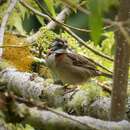Comprehensive Description
provided by Smithsonian Contributions to Zoology
Zonotrichia capensis (P. L. S. Müller)
The wide-ranging chingolo sparrow is perhaps the commonest victim of the shiny cowbird, especially in Argentina and in eastern Brazil. Recently Eugene Gerzenstein has informed us that it is also the most frequent host in Uruguay, although no specific instances from that country have so far appeared in the literature. The Uruguayan records involve the host race Z. capensis hypoleuca.
The northeasternmost subspecies of the sparrow, Z. capensis costaricensis, may now be added to the 10 others of its geographic races previously known to be parasitized. A. H. Miller (1963:47) reported it as a victim of M. bonariensis cabanisii in Colombia (San Antonio, western Andes). Dr. J. I. Borrero informs us that he has observed similar cases near Cali, Colombia. The fact that in Chile the chingolo (Z. capensis chilensis) is frequently victimized by the shiny cowbird is evidenced by 5 parasitized sets of eggs, all collected by J. D. Goodall near Santiago, and currently in the collections of the Western Foundation.
The Venezuelan race of this sparrow (Z. capensis venezuelae) was previously (Friedmann, 1949:157) noted as a victim of the shiny cowbird on the basis of a single record near Caracas. Recently, Mr. W. H. Phelps, Jr., has informed us that in the past few years he has noted many such cases in that area. This is in keeping with the situation elsewhere in South America; where the rufous-collared sparrow and the shiny cowbird occur together, the former seems usually to be a favorite host choice of the latter. In areas where the sparrow does not occur, as in parts of the states of Monagas and Anzoategui, in northeastern Venezuela, the shiny cowbird seems to concentrate its parasitism on the grackle Quiscalus lugubris, as in the field experience of Foster D. Smith (Friedmann and Smith, 1955:514). In Trinidad, the wren, Troglodytes musculus, is the favorite host choice, but in northeastern Venezuela Foster Smith did not find the wren to be parasitized, although it breeds there.
King's study of the rufous-collared sparrow in Tucumán, northwestern Argentina (1973) has corroborated, even extended, the almost incredibly high incidence of parasitism previously noted for it in that area (Friedmann, 1929:113–114)—66.0 percent of all the nests for the entire breeding season (33 out of 50 nests under observation) contained 1 or more eggs of the shiny cowbird, and at the peak of the sparrow's breeding season, 100 percent were so affected!
BLACK-CAPPED WARBLING-FINCH
Poospiza melanoteuca (d'Orbigny and Lafresnaye)
Previously known (Friedmann, 1929:115) as a shiny cowbird host in Tucumán Province, northwestern Argentina, on the basis of 2 parasitized sets of eggs taken at Manchalá, by Pablo Girard, in 1925, there is now a third record from the same locality, by the same collector, 24 November 1930, in the collections of the Museo de La Plata.
RINGED WARBLING-FINCH
Poospiza torquata (d'Orbigny and Lafresnaye)
To the single earlier record of this finch as a victim of the shiny cowbird (Friedmann, 1971:251), may be added a second, a nest with a well developed young cowbird, found in December 1967, in the Lerma Valley, Salta Province, Argentina, by Gunnar Hoy. The race P. torquata pectoralis is the subspecies of the host involved in Salta, as in the earlier record from San Luis, Argentina.
BLACK-AND-RUFOUS WARBLING-FINCH
Poospiza nigrorufa (d'Orbigny and Lafresnaye)
Previously (Friedmann, 1929:117) this warblingfinch was known as a victim of the shiny cowbird in the Cape San Antonio region, Buenos Aires Province, Argentina, where Gibson had so recorded it. We now learn of a later record from the same area, taken 15 January 1933, by Col. R. Runnacles, and now in the Museo de La Plata, and of another parasitized nest found 26 November 1967 at Atalaya, Buenos Aires, by S. Narosky.
GREAT PAMPA-FINCH
- bibliographic citation
- Friedmann, Herbert, Kiff, Lloyd F., and Rothstein, Stephen I. 1977. "A further contribution of knowledge of the host relations of the parasitic cowbirds." Smithsonian Contributions to Zoology. 1-75. https://doi.org/10.5479/si.00810282.235

